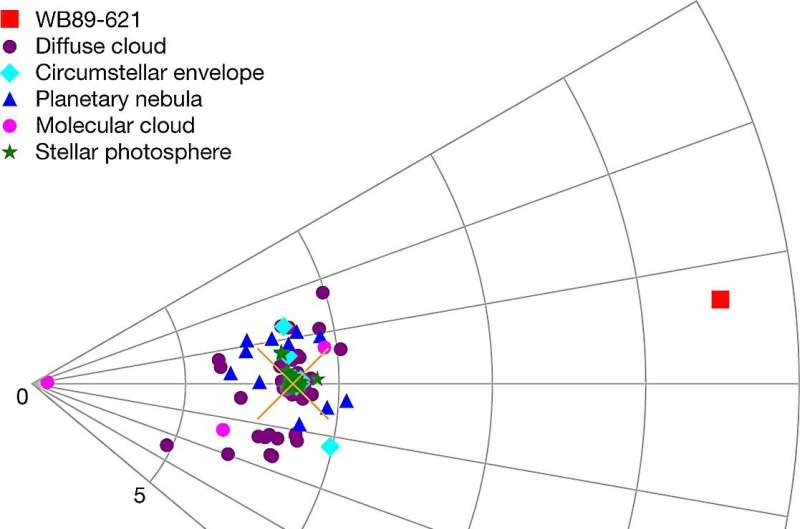November 13, 2023 report
This article has been reviewed according to Science X's editorial process and policies. Editors have highlighted the following attributes while ensuring the content's credibility:
fact-checked
peer-reviewed publication
trusted source
proofread
Phosphorus discovered in outskirts of the Milky Way for the first time

A trio of chemists at the University of Arizona, with an affiliation to the University of Arizona's Department of Astronomy and Steward Observatory has discovered phosphorus in the outskirts of the Milky Way galaxy for the first time. In their project, reported in the journal Nature, Lilia Koelemay, Karlie Gold and Lucy Ziurys studied the gas cloud WB89-621.
Prior research has shown that phosphorus exists near the sun and also other inner parts of the Milky Way galaxy, but until now, it had not been observed in its outer parts. Prior findings have not been surprising, as other research has shown that phosphorus is created when silicon atoms in stars (such as the sun) bond with neutrons. Such stellar nucleosynthesis is believed to be responsible for observed phosphorus.
It also seemingly has explained why phosphorus has not been found farther way from the sun—there would be no plausible way for it to get there. In this new effort, the researchers were studying the chemical makeup of gas cloud WB89-621, which is situated near the outer edges of the Milky Way, when they found something unexpected.
In their work, the researchers were conducting a millimeter spectra analysis of PO and PN when they noted rotational lines suggesting the presence of phosphorus in the cloud, which was a distance of 22.6 kpc from the center of the Milky Way galaxy. They note also that supernovae do not exist in the outer regions of the Milky Way, suggesting that the phosphorus they observed came from another source.
The researchers note that two possible sources are not credible. Galactic fountains (where material from supernova is moved via circumgalactic and/or halo effects), for example, could not explain their finding because clouds created by such fountains are not found in the Milky Way at such distances.
Another possible explanation could be a contribution from an extragalactic source, such as the Magellanic Cloud. But that also seems implausible, they note, because such sources rarely have enough metals needed to produce the amounts of phosphorus they detected.
The team concludes that other possible sources will need to be investigated to determine the source of the phosphorus they found.
More information: L. A. Koelemay et al, Phosphorus-bearing molecules PO and PN at the edge of the Galaxy, Nature (2023). DOI: 10.1038/s41586-023-06616-1
Journal information: Nature
© 2023 Science X Network





















